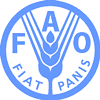 |
|||||||||
|
|||||||||||||||||||
|
|
FAO to Help Small Farmers Increase Food Production FAO has begun emergency activities worth US$ 17 million to respond to historically high food prices, which threaten to leave the globe’s 862 million people afflicted by hunger in an even worse situation, and push millions more people back into extreme poverty and hunger.
The start-up funds will cover the immediate needs to give small farmers in some of the poorest countries the seeds, fertilizers, and other tools they need to boost agricultural production for the upcoming planting seasons through 2009. But the countries most affected, especially in Africa, will need much more – a total of US$1.7 billion in the same period – to start to revive agricultural systems that have been neglected for several decades. The FAO Initiative on Soaring Food Prices, launched in December 2007 to respond to the price crisis, aims to not only increase the food supply starting right now during this planting season, but also to ensure that impoverished farmers seize the opportunity to lift themselves out of poverty. Poor farmers stand to benefit from high prices and boost the supply of locally available food, while helping to bring prices back down. This is especially important in low-income countries that rely heavily on imports to meet their food needs. “The high prices are a burden for all of us, no one will be immune,” said FAO’s Assistant Director-General, José Maria Sumpsi. “At the same time, in countries where agriculture has fallen to the wayside because it was cheaper to import food than try to produce locally, farmers have the incentive to produce and make a living while securing food supplies at the global level,” Mr Sumpsi continued. “Prices have been steadily rising for some time, but the sudden sharp jump this year is just one small symptom of an illness caused by years of neglect of world agriculture. This imbalance now threatens the lives of the poorest and most vulnerable people, who have been priced out of the food they need to survive,” Mr.Sumpsi said. More seeds and tools The Initiative, to be put in motion at countries’ request, will provide much more than seeds and tools to kick-start planting. It identifies key areas where action must be taken to increase food supply: First: seeds, fertilizer and tools together with good advice to ensure the best possible use is made of the supplies, which will lay the foundations for sustainable intensification of production in the future; Second: work to improve infrastructure such as irrigation systems, market infrastructure, and better rural roads; Third: know-how to add value to smallholder farmers’ final marketable product, by raising crop varieties that are higher-quality and higher-yielding, or by utilizing processing techniques to diversify products, and facilitating supply contracts with agricultural companies that are secure and beneficial to farmers; Fourth: reducing losses, sometimes as much as one-fifth of the harvest, through better handling, milling and storage, defending crops and livestock from pests, sickness and disease, for example, through integrated pest management systems; and taking measures to limit the impact of natural disasters. In all these areas, FAO offers technical assistance and advice, as well as support in delivery where the organization already has strong emergency programmes in place. Much of the work entails a scaling-up of existing long-term programmes to support agriculture and rebuild the livelihoods of the rural poor, 80 percent of whom make their living in farming. FAO will also provide regional coordination to ensure a seamless strategy in countries with close physical and market links. FAO is working closely with UN partners, most importantly the World Food Program and the International Fund for Agricultural Development, as well as the World Bank, the International Monetary Fund, and regional organizations and development banks. Activities have begun or are beginning by June in five countries: Burkina Faso, Mauritania, Haiti, Senegal, and Mozambique. Recent assessment missions include Cambodia, Côte d’Ivoire and the Philippines. FAO is also contributing to a Comprehensive Framework for Action, created through the UN Secretary General’s High-Level Taskforce on the Global Food Security Crisis, partnered with other UN agencies and the Bretton Woods Institutions.
|
||||||||||||||||||

|
|
||||||||||||||||||
| home | agri-services | pedigree
pen | news | dairy | beef | machinery property | organisations | site map |
|||||||||||||||||||


